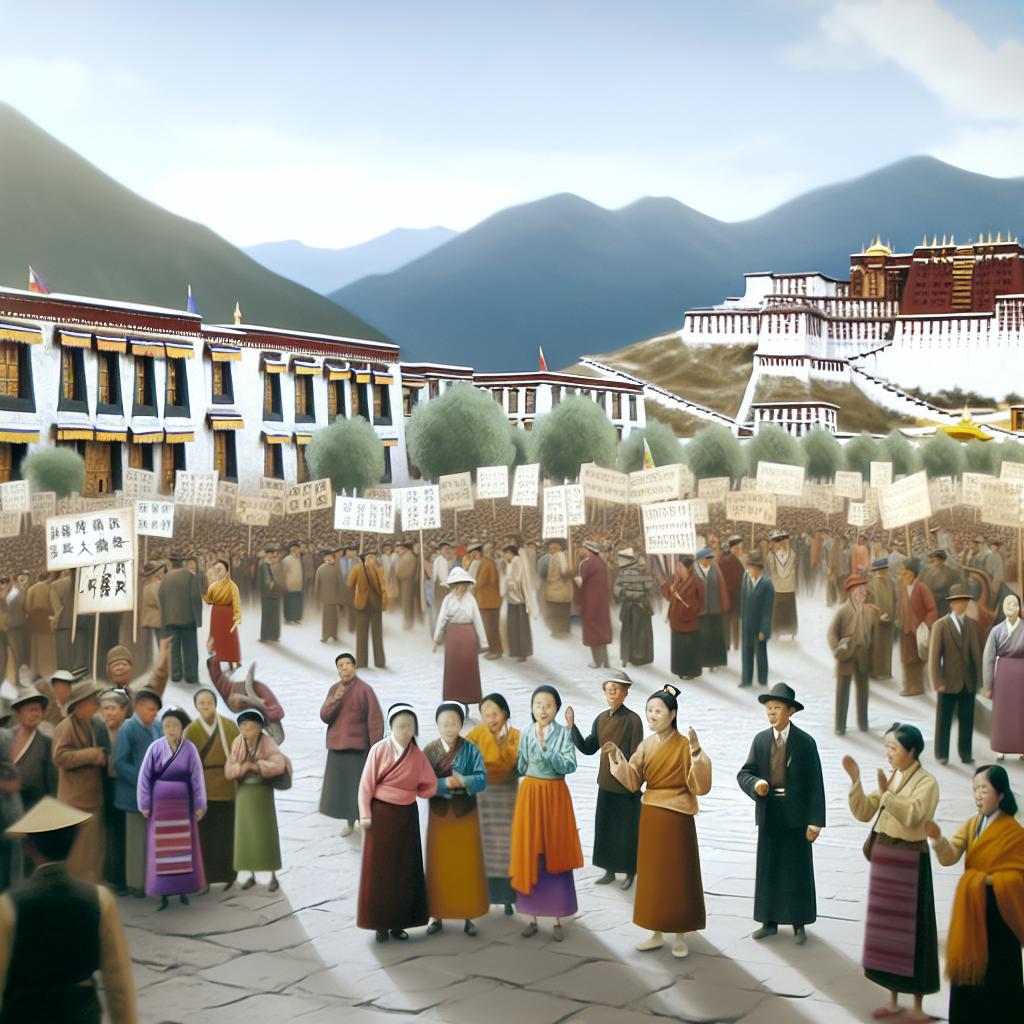The Tibetan Uprising of 1959
In 1959, Tibet was the scene of a critical event that significantly influenced its future and its geopolitical dynamics with China—the Tibetan Uprising. This tumultuous event was characterized by escalating tensions between the local Tibetan populace and the Chinese government, which had increasingly asserted its control over the region.
Background to the Uprising
The roots of the uprising can be traced back to the year 1950, marked by the entry of the People’s Liberation Army (PLA) into Tibet. This move was part of China’s broader strategy to assert sovereignty over the territory. In 1951, the Seventeen Point Agreement was signed, a pivotal document promising Tibet a certain degree of autonomy within the governance framework of the People’s Republic of China. While autonomy was officially promised, a significant section of the Tibetan populace felt that the agreement was not a reflection of their true aspirations and believed it to be imposed upon them without genuine consent.
Political and Cultural Tensions
During the subsequent years, as the Chinese government began implementing various policies, many Tibetans perceived these actions as a direct threat to their traditional way of life and religious practices. The newly initiated land reforms were seen as a challenge to traditional Tibetan systems. More provocatively, attempts to curtail the influence of Tibetan Buddhism—a cornerstone of Tibetan identity and spirituality—further inflamed discontent and dissatisfaction. This period was marked by increasing friction, as the Tibetans sought to preserve their cultural and religious identity amid expanding Chinese control.
The Outbreak of the Uprising
The palpable tension reached a boiling point on March 10, 1959. On this day, a spontaneous protest erupted in Lhasa, the capital of Tibet. Thousands of Tibetans gathered around the Norbulingka Palace, where the Dalai Lama, Tibet’s spiritual leader, resided during the summer months. The immediate catalyst for this mass assembly was the fear that the Chinese authorities intended to abduct the Dalai Lama—rumors of such a plan had circulated widely, fueling anxiety and action. This gathering quickly escalated into a broader uprising, representing open defiance against Chinese rule and asserting the Tibetans’ demands for autonomy and preservation of their cultural identity.
Key Events and Escalation
As the uprising gathered momentum, the protests rapidly spread beyond Lhasa, affecting other significant regions across Tibet. Facing widespread dissent, the Chinese government responded with decisive military force, a move that led to numerous skirmishes and significant casualties among the Tibetan population. The uprising’s intensity crescendoed with a pivotal event occurring on March 17, when the Dalai Lama, apprehensive of the threats to his life, fled Tibet, crossing into India where he was granted asylum. This marked a significant turning point; the Dalai Lama became not only a symbol of Tibetan resistance but also the face of the international movement advocating for Tibetan autonomy.
Consequences of the Uprising
The aftermath of the uprising was severe and multifaceted. Thousands of Tibetans lost their lives in the conflict’s brutal suppression, and following the uprising, the Chinese government tightened its grip on the region. Cultural and religious repression deepened considerably: monasteries, central to Tibetan culture and spirituality, were demolished, and many Tibetan cultural practices faced systematic suppression. The intention behind these measures was clear—an endeavor to assimilate Tibet into the Chinese cultural and political fold more completely and diminish any movements aimed at autonomy or independence.
Exile and Global Awareness
The exodus of the Dalai Lama to India was a catalyst for heightened international awareness regarding the Tibetan plight. Over subsequent decades, Tibetan refugees, alongside their government-in-exile based in Dharamshala, India, played a crucial role in generating global awareness and advocacy efforts. This diaspora community has been instrumental in rallying international support for the cause of Tibetan autonomy, bringing the issue to the global stage and influencing international public opinion.
Legacy of the Uprising
The Tibetan Uprising of 1959 continues to stand as a pivotal moment in the history of Tibet. Today, it symbolizes Tibet’s enduring quest for autonomy and highlights the ongoing challenges it faces under Chinese administration. Every year on March 10, Tibetans and supporters worldwide commemorate the events of 1959, reminding the world of the resilience of Tibetan cultural identity and the aspiration for self-determination. These commemorations serve not only as a form of resistance but also as a testament to the enduring spirit of the Tibetan people in preserving their unique cultural and religious heritage.
In summary, the complexities surrounding the Tibetan Uprising attest to the ongoing challenges of maintaining cultural integrity amidst external political control. For an in-depth understanding, one may consider perusing scholarly articles or resources provided by organizations dedicated to Tibetan issues. By revisiting these events, one can gain a deeper appreciation of the historical, cultural, and political dimensions that continue to define the Tibetan narrative.

